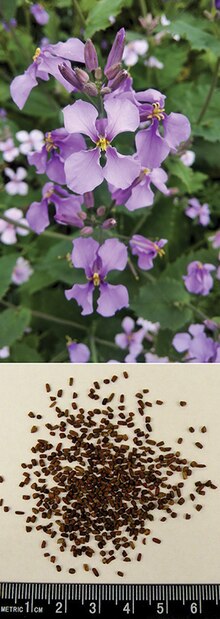
| |
| Names | |
|---|---|
| Preferred IUPAC name (7R,15Z,18R,21Z)-7,18-Dihydroxytetracosa-15,21-dienoic acid | |
| Other names 7,18-di-OH-24:2-delta-15c,21c | |
| Identifiers | |
| CAS Number | |
| 3D model (JSmol) | |
| ChEBI | |
| PubChem CID | |
| CompTox Dashboard (EPA) | |
InChI
| |
SMILES
| |
| Properties | |
| Chemical formula | C24H44O4 |
| Molar mass | 396.612 g·mol |
| Except where otherwise noted, data are given for materials in their standard state (at 25 °C , 100 kPa). Infobox references | |
Wuhanic acid ((7R,15Z,18R,21Z)-7,18-dihydroxytetracosa-15,21-dienoic acid) is a 24-carbon dihydroxy fatty acid with the chemical formula C
24H
44O
4 and molecular weight 396.6 g/mol.
Wuhanic acid was identified, along with nebraskanic acid, as a major fatty acid of the seed oil of Chinese violet cress (Orychophragmus violaceus L. O.E.Schulz). Wuhanic acid was named in honor of the location of its co-discoverer Chunyu Zhang, a professor in the National Key Lab of Crop Genetic Improvement and College of Plant Science and Technology at Huazhong Agricultural University in Wuhan, Hubei, China.

Biosynthesis
Wuhanic acid is believed to arise in part from a "discontinuous elongation" pathway as described for nebraskanic acid biosynthesis. In the proposed biosynthetic pathway, oleic acid bound to phosphatidylcholine is converted to ricinoleic acid by a 12-hydroxylase, a functional variant of the FAD2 Δ12 oleic acid desaturase. Ricinoleic is subsequently released to the acyl-CoA pool where it is elongated to a C20 intermediate. At the second step of fatty acid elongation, the C20 3-OH intermediate is elongated to a C22 5-OH fatty acyl-CoA by a variant FAE1 β-ketoacyl-CoA synthetase. This elongation of the 3-OH intermediate prior to the completion of a full fatty acid elongation cycle was termed discontinuous elongation. This fatty acid undergoes a subsequent complete elongation cycle to form the C24 7,18 dihydroxy fatty acid nebraskanic acid. The omega-3 double bond is believed to be introduced during wuhanic acid biosynthesis by a FAD3 ω-3 fatty acid desaturase.
Functionality
Chinese violet cress oil contains 35% to 50% of the C24 dihydroxy fatty acids wuhanic and nebraskanic acids. This oil was shown to have superior lubricity at 100 °C in metal-on-metal lubrication studies compared to ricinoleic acid-rich castor oil. In these studies, Chinese violet cress oil had ~4-fold lower coefficient of friction relative to castor oil. The unique functionality of Chinese violet cress oil was speculated to result from fatty acids binding to the hydroxyl groups of wuhanic and nebraskanic acids in triacylglycerols to form complex estolides.
References
- "PlantFAdb: 7,18-di-OH-24:2-delta-15c,21c; Wuhanic acid; (7R,15Z,18R,21Z)-7,18-dihydroxytetracosa-15,21-dienoic acid; 7,18-Dihydroxy-15,21-tetracosedienoic acid, (15Z,21Z)-". plantfadb.org.
- PubChem. "MYDDZMLKINSENR-TZWOSKRLSA-N". pubchem.ncbi.nlm.nih.gov. U.S. National Library of Medicine, National Center for Biotechnology Information. Retrieved 2019-03-30.
- "Fig. 3a, b Hydroxy fatty acid contents of seeds from individual..." ResearchGate. Retrieved 2019-03-30.
- ^ Li, Xiangjun; Teitgen, Alicen M.; Shirani, Asghar; Ling, Juan; Busta, Lucas; Cahoon, Rebecca E.; Zhang, Wei; Li, Zaiyun; Chapman, Kent D.; Berman, Diana; Zhang, Chunyu; Minto, Robert E.; Cahoon, Edgar B. (27 August 2018). "Discontinuous fatty acid elongation yields hydroxylated seed oil with improved function". Nature Plants. 4 (9): 711–720. Bibcode:2018NatPl...4..711L. doi:10.1038/s41477-018-0225-7. PMID 30150614. S2CID 52095084.
- Wenz, John (27 August 2018). "This Purple Plant Has a Secret That Could Replace Synthetic Engine Oil". Popular Mechanics.